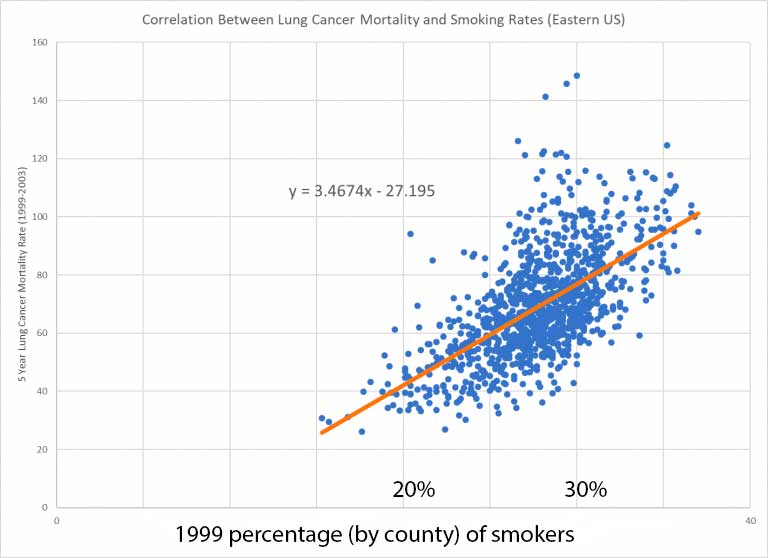Patterns of experience
We are constantly seeking to make sense of the world by identifying patterns.
Graphs and visual info
We are constantly seeking to make sense of the world by identifying patterns.
Our eyes / visual system are able to take in and make sense of enormous amounts of information.
Therefore the language we use for talking about patterns is visual and much of it refers to graphical displays of information.
Mathematics deals with patterns: Some simple terms used in math capture visual aspects that we can easily see when data is graphed...
- There is a "relation" between cause (x) and effect (y)
- But correlation is not alway causation...
- when $x$ increases, $y$ increases as well.
- when $x$ increases, $y$ decreases.
Smoking
 Lung Cancer Mortality in the Eastern United States
Lung Cancer Mortality in the Eastern United States
What does this graph tell us?
Some common ways of talking...
- The quantity $y$ increases as the quantity $x$ increases,
- $y(x)$ is an increasing function of $x$,
- As $x$ decreases, so does $y$,
- Changes in $x$ cause $y$ to change (But "correlation does not always mean causation").
Going to jail
 Via The Washington Post
Via The Washington Post
25th income percentile =
= These parent earn more than 25% of the population.What does this graph tell us?
- Which end of the scale is rich and which is poor?
- Say what the circled points at either end of the graph mean, using numbers.
- Use phrases like "as [something] increases [something else] increases" or "as [something] decreases [something else] increases".
- How would you describe the overall message of this graph? (In sentence, or at most two)
Gravitational energy?
- Operative definition: An object has energy if
it has the potential to physically change itself or its environment.

Does a book on a high shelf have the "potential to physically change itself or its environment"?If so, what variables (characteristics of an object) does that depend on?
Dropping boulders
What combination of weight, $w$, and height, $h$, above the road expresses the destructive potential (we'll call this the "Gravitational Energy"=GravE)) of boulder?
- $\frac wh$
- $\frac hw$
- $wh$
- $\frac{1}{wh}$
We considered that something that "weighs" more (say, 200 lbs, instead of 20 lbs) has more destructive potential than a lighter object.
We considered that something that falls from a greater height (say 3 meters instead of 2 meters) has more destructive potential than something that falls only a short distance.
So we want the mathematical combination of $w$ and $h$ that gives us the largest number when $w=2$ and $h=3$, and the smallest number when $w=1$ and $h=1$. Let's test and compare...
test... with $w=1$, $h=1$ with $w=2$, $h=3$ $\frac wh$ $\frac{1}{1}=1$ $\frac{2}{3}=0.67$ $\frac hw$ $\frac{1}{1}=1$ $\frac{3}{2}=1.5$ $wh$ 1*1=1 2*3=6.0 $\frac{1}{wh}$ $\frac{1}{1*1}=1$ $\frac{1}{2*3}=\frac 16=0.17$ $$\text{GravE}=wh$$ Seems to do the best job of this:
One approach is try out these possible formulas with some actual numbers and see which combination matches up with our intuition about the danger (destructive potential) of objects of different weights and at different heights. Fill in a table like this one...

Here is a picture of a very large "battery" for storing GravE:

Is there a battery that could store enough energy for a city?
Weight
What do we mean by "weight"?
Two aspects:
- How much *stuff*...that is "atoms" (and what kind).
- What planet are we on? (table)
An astronaut wearing a spacesuit and a backpack with life support equipment is weighed on scale on Earth, and comes out at 300 lbs. But On the moon he weighs just 50 lbs.
--OR-- even on Earth there are variations in what a scale would read:
Are we floating in the ocean? or standing on land?
Weight = mass * strength of gravity ($g$) = $mg$.
Your mass does not change from planet to planet, but the strength of gravity may change.
With your mass in kg and the strength of gravity in m/sec^2 (the table) this expression gives the force of gravity acting on you in (metric units) "Newtons" or (english units) "pounds".
Weight=$mg$The weight of an object the force of gravity on the object. It is not just the number of kilograms. On Earth it is kilograms multiplied by our gravitational acceleration, $g=9.8$ m/sec^2
The units of weight are apparently [kilograms$\cdot$m/sec^2] = "Newtons".
Examples
- The weight on Earth of someone who has a mass of 68 kg (=150 lbs) is 68 kg $\times$ 9.8 m/sec^2 = 666.4 kg m/sec^2 = 666.4 Newtons.
- The force of gravity on Earth acting on a 2 kg book is 2 kg$\times$ 9.8 m/sec^2 = 19.6 N
Hobson (textbook) usually approximate $g$ as 10 m/sec^2. So that 2 kg book weighs approximately 20 N.
So our final expression for gravitational energy, which also takes into account your planet is
$$\text{GravE} = m g h$$
